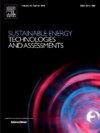整合废热转换和可持续能源生产的生命周期分析:对环境和经济影响的反思
IF 7
2区 工程技术
Q1 ENERGY & FUELS
Sustainable Energy Technologies and Assessments
Pub Date : 2025-05-10
DOI:10.1016/j.seta.2025.104342
引用次数: 0
摘要
为了在可持续发展模式下实现社会繁荣,废物管理是一项重大挑战,也是一个巨大的机遇。与传统的垃圾填埋不同,垃圾发电技术的目的是回收垃圾中的能量,将其转化为有价值的资源。垃圾填埋是垃圾分类中最不可取的做法。本研究分析了世界各地收集的各种生物质和固体废物样品,以阐明它们的性质和应用,并将它们与不同处理和增值技术的适用性联系起来。以城市固体废物为例,讨论了三种技术的环境和成本分析。解释了排放的化学品和污染物、节省的资源和避免排放的影响,同时将成本与国家供应结构中的电力使用进行了比较。在全球变暖潜势、海洋和人类毒性方面,焚烧显示出比气化方案更高的影响,而在富营养化、非生物耗竭和陆地毒性方面则较低。所有技术都描述了酸化、臭氧消耗和光化学氧化电位的功劳,主要是NOx、SO2、R114、无机CO和非甲烷挥发性有机化合物的排放。从经济角度来看,焚烧比从国家电网购买能源的成本更低。这项研究强调了为区域废物的具体特征制定量身定制战略的重要性,同时考虑到每种技术的不同适用性。作为未来的方向,这项研究显示了到目前为止尚未广泛实施的技术的更广泛适用性的权衡。本文章由计算机程序翻译,如有差异,请以英文原文为准。

Integrating waste thermal conversion and lifecycle analysis for sustainable energy production: Reflecting upon environmental and economic impacts
Aiming at a society that thrives within the sustainable development model, managing waste is a critical challenge and a huge opportunity. Unlike traditional landfilling, which stands as the least advisable practice in the waste hierarchy, the purpose of waste-to-energy techniques is to recover the energy embedded within waste, transforming it into valuable resources. This research analyses various biomass and solid waste samples collected worldwide to elucidate their properties and applications, correlating them with the suitability of different treatment and valorization techniques. A case study is presented for municipal solid waste, the environmental and cost analysis of three techniques being discussed. The impacts of emitted chemicals and pollutants, saved resources and avoided emissions were explained, while costs were compared to the use of electricity from the national supply mix. Incineration has shown higher impacts than gasification schemes for global warming potential, marine and human toxicity, and lower in eutrophication, abiotic depletion and terrestrial toxicity. All techniques depicted credits for acidification, ozone depletion and photochemical oxidation potential, mostly ruled by NOx, SO2, R114, inorganic CO and non-methane volatile organic compound emissions. Paradigmatically, the economic perspective shows that incineration presents lower costs than that of purchasing energy from the national grid. This study underscores the importance of tailored strategies for specific characteristics of regional waste, taking into consideration the different applicability of each technique. As future directions, this study shows the trade-offs for broader applicability of techniques that so far are not yet as widely implemented.
求助全文
通过发布文献求助,成功后即可免费获取论文全文。
去求助
来源期刊

Sustainable Energy Technologies and Assessments
Energy-Renewable Energy, Sustainability and the Environment
CiteScore
12.70
自引率
12.50%
发文量
1091
期刊介绍:
Encouraging a transition to a sustainable energy future is imperative for our world. Technologies that enable this shift in various sectors like transportation, heating, and power systems are of utmost importance. Sustainable Energy Technologies and Assessments welcomes papers focusing on a range of aspects and levels of technological advancements in energy generation and utilization. The aim is to reduce the negative environmental impact associated with energy production and consumption, spanning from laboratory experiments to real-world applications in the commercial sector.
 求助内容:
求助内容: 应助结果提醒方式:
应助结果提醒方式:


